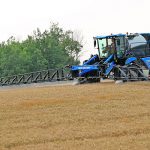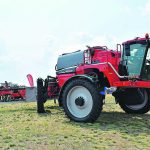Case IH has joined the ranks of brands offering variable-rate and spot-spray technology on its application equipment.
Tag Archives sprayer

Selective spray with Case IH SenseApply
Variable-rate and spot-spray technology is now on offer for Patriot sprayers and Trident applicators

Clean water improves the efficacy of herbicides
Farmers urged to drop the water volume in their mixes when using hard water because cations can tie up herbicide
Glacier FarmMedia – Water cleanliness should be a top priority for producers when sourcing water for spraying said Kim Brown, Manitoba provincial weeds specialist. Spraying with dirty water risks contaminants tying up active ingredients in herbicides, rendering them ineffective. “If you’ve got dirty water, (substances in there) will actually antagonize or will tie up glyphosate […] Read more
Sprayer tech a hit in North America
Manufacturers face tougher rules in Europe, which forced them to develop better clean-out systems for their equipment
LANGHAM, Sask. — European sprayer design and technology have been catching the eyes of farmers across Western Canada. Sprayer manufacturers Agrifac and Horsch have recently expanded their markets into Canada and garnered a lot of attention. Independent sprayer consultant Tom Wolf believes the European manufacturers are ahead of the curve when it comes to innovation. […] Read more
Precision sprayer easy on crop
Ecorobotix recently sold its first Canadian sprayers to two major Quebec vegetable growers who each crop more than 1,000 acres. They deliver fresh produce daily direct to New York and Boston. One of those growers is Guillaume Cloutier. “We use it every day,” he says. “I think we’ve sprayed about 700 acres with it so […] Read more

Precision sprayer cuts chemical use
Makers of the Ecorobotix ARA claim their sprayer can apply chemical to a crop using one nozzle per row and that it is individually triggered to turn on and off using instructions from a single sensor dedicated solely to reading that specific crop row, on a 20-foot sprayer at 4.7 m.p.h. Not only that, the […] Read more





